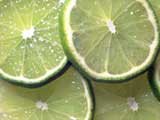GLOSSARY TERMS - 'C'
 In botany, calyx is a collective term for all of the sepals, structural components of the flower.
In botany, calyx is a collective term for all of the sepals, structural components of the flower.
 A variety of melon (Cucumis melo var. reticulates) having a tan rind with netlike ridges and the sweet fragrant orange flesh.
A variety of melon (Cucumis melo var. reticulates) having a tan rind with netlike ridges and the sweet fragrant orange flesh.
![]() A covering that is used on the top and at the neck of a wine bottle to protect the cork.
A covering that is used on the top and at the neck of a wine bottle to protect the cork.
 Any of a variety of fruit grown on a shrub or also on small shrub-like tree that are not considered domestic tree cherries. Some of the varieties of Bush Cherries include the Nanking cherry, Hansen's Bush cherry, Pin cherry, Sand cherry, Joy Cherry, Chinese Bush cherry, Korean Bush cherry, and also the Chokecherry. Bush cherries are universally used to make pies, baked sweets, jams, jellies, syrups, juices, and also concentrate.
Any of a variety of fruit grown on a shrub or also on small shrub-like tree that are not considered domestic tree cherries. Some of the varieties of Bush Cherries include the Nanking cherry, Hansen's Bush cherry, Pin cherry, Sand cherry, Joy Cherry, Chinese Bush cherry, Korean Bush cherry, and also the Chokecherry. Bush cherries are universally used to make pies, baked sweets, jams, jellies, syrups, juices, and also concentrate.
 A mid-sized to large citrus fruit that is grown in quite a lot of different variations, all similar in taste and aroma. The citron has a thick rough skin, which provides a very bitter taste, typically considered unpalatable. When candied, the peel becomes translucent and more attractive as a garnish or ingredient in marmalades and jams
A mid-sized to large citrus fruit that is grown in quite a lot of different variations, all similar in taste and aroma. The citron has a thick rough skin, which provides a very bitter taste, typically considered unpalatable. When candied, the peel becomes translucent and more attractive as a garnish or ingredient in marmalades and jams
 Citrus is a common term and genus of flowering plants in the family Rutaceae, originate in tropical and subtropical Southeast Asia. The plants are great shrubs or small trees, reaching 5-17 m tall, with spiny shoots and alternately prearranged evergreen leaves with an entire margin.
Citrus is a common term and genus of flowering plants in the family Rutaceae, originate in tropical and subtropical Southeast Asia. The plants are great shrubs or small trees, reaching 5-17 m tall, with spiny shoots and alternately prearranged evergreen leaves with an entire margin.
 A compound fruit is one, which develops from several ovaries in either a single flower or even multiple flowers . Conversely, a simple fruit develops only from one ovary.
A compound fruit is one, which develops from several ovaries in either a single flower or even multiple flowers . Conversely, a simple fruit develops only from one ovary.
 The Custard-apple (Annona reticulate) is known in English as bullock's heart or bull's heart, does a species of Annona, native to the tropical New World, prefer a low elevation, and a warm, humid climate. It is a very small deciduous or even semi-evergreen tree reaching 12 m tall. The leaves are alternate, simple, oblong-lanceolate, 10-13 cm long and 5-12 cm broad. The flowers are produced in clusters, each flower 2-3 cm across, with six yellow-green petals.
The Custard-apple (Annona reticulate) is known in English as bullock's heart or bull's heart, does a species of Annona, native to the tropical New World, prefer a low elevation, and a warm, humid climate. It is a very small deciduous or even semi-evergreen tree reaching 12 m tall. The leaves are alternate, simple, oblong-lanceolate, 10-13 cm long and 5-12 cm broad. The flowers are produced in clusters, each flower 2-3 cm across, with six yellow-green petals.
A dry, indehiscent, one-seeded fruit that is formed from an inferior ovary. Common to the Astraea family.
 The Canistel is an evergreen tree national to southern Mexico & Central United States. The canistel grows up to ten meters (33 ft) high, & produces orange-yellow fruit, also called yellow sapote, up to 7 centimeters long, which are poisonous if eaten raw. Canistel flesh is sweet, with a surface often compared to that of a cooked egg yolk, hence its colloquial name of "eggfruit." It is closely related to the Mamey sapote & abiu.
The Canistel is an evergreen tree national to southern Mexico & Central United States. The canistel grows up to ten meters (33 ft) high, & produces orange-yellow fruit, also called yellow sapote, up to 7 centimeters long, which are poisonous if eaten raw. Canistel flesh is sweet, with a surface often compared to that of a cooked egg yolk, hence its colloquial name of "eggfruit." It is closely related to the Mamey sapote & abiu.















